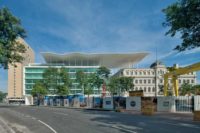On public works projects
| Photo © MMBB Arquitetos |
| Urban Project for Antonico Creek reconciles a S'o Paulo favela and its area's waterways. |

“The way we typically work at MMBB, with projects such as Jardim Edite (a multi-tower public-housing project in a central business district that includes social services such as a clinic and day-care center for residents), we are contracted to develop the design as well as oversee the construction.
This is in contrast to what usually happens with public works, where you do not necessarily have the participation of architects throughout the process. The contracts are held by large construction companies, which employ architects but retain control over the contract.
The vision of the city as reflected in the government's My House My Life housing program, with its endless repetition of all these small identical houses way out on the urban perimeter, is horrible. We know that the centers of our cities have great potential. There are a large number of abandoned buildings and empty lots that could be reoccupied. This policy of building on the periphery is horrible. We are sending people far away from where the jobs are, meaning they will be dependent on a public transportation system that is often of poor quality, and sometimes does not even exist. It will be a disaster.
The problem is not just a question of the law [Law 8.666] demanding that authorities contract the cheapest bid to execute these projects—this is about political priorities. My House My Life ended up being a major profit generator for construction companies.
But there is a new generation in the public sector that has another vision, architects and planners who have backgrounds and educations that have equipped them to confront the challenges we face. There are now more architects and planners in authority who are better prepared to navigate policy across the various bureaucracies—something that has often failed to happen in the past.
The latest version of the master development plan for São Paulo is an example of this. It involved calling all the architectural institutions in Brazil for a debate on the revisions. This puts the discussion on another level—not just for architects, but also for society in general. This is important, because the scale of São Paulo [a metropolis of more than 11 million inhabitants] is so challenging.”





Post a comment to this article
Report Abusive Comment